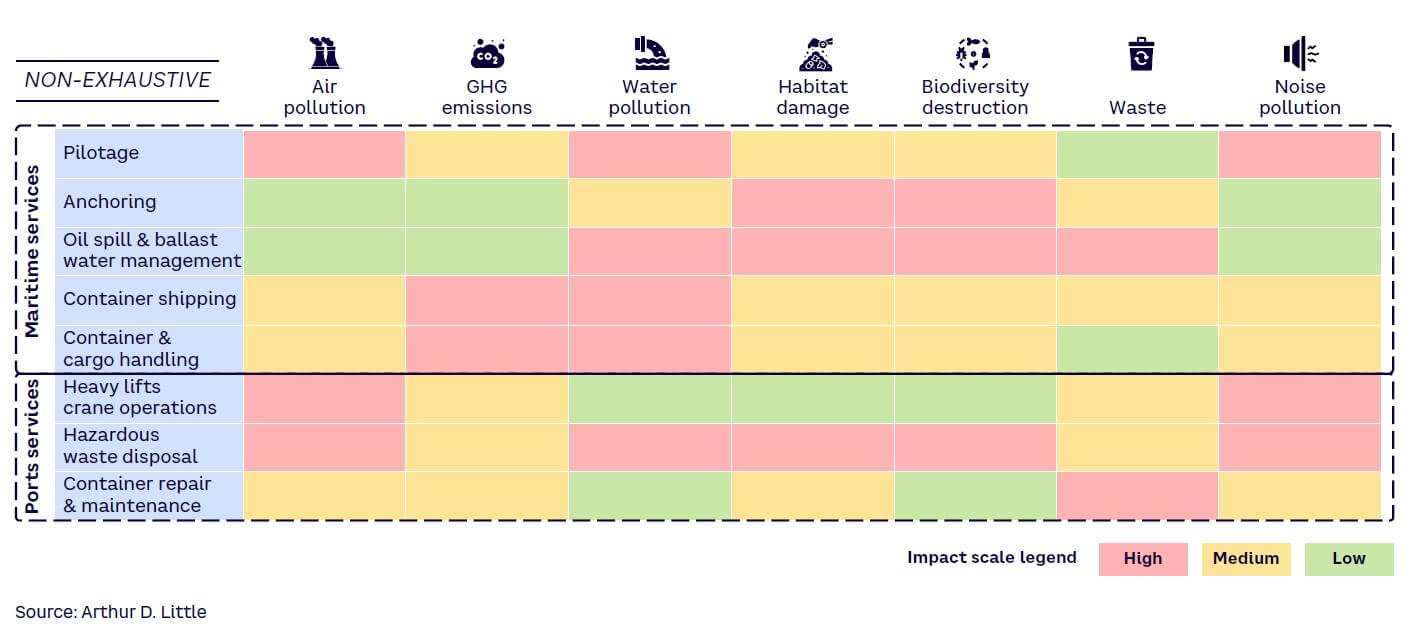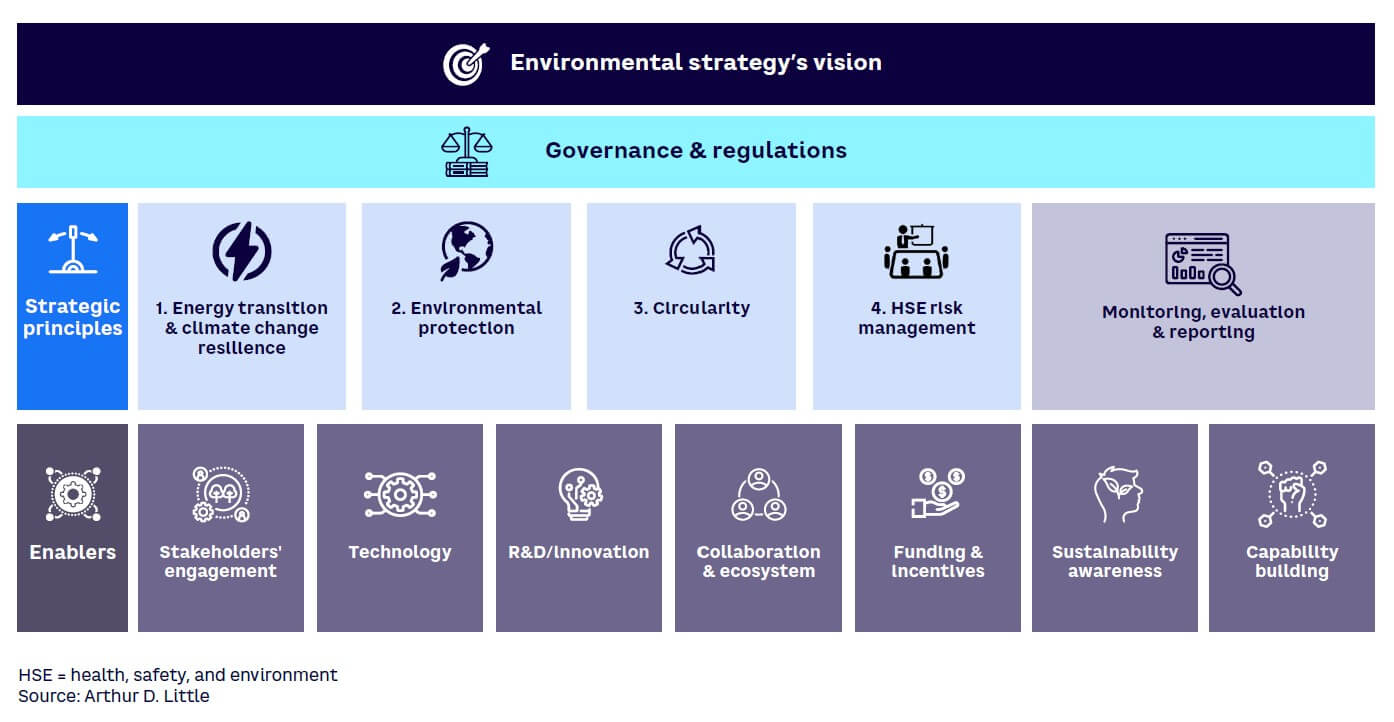Of the top five issues impacting the port and maritime industry, three relate to environmental risks — a position that has not changed over the last five years. The sector must therefore drive the decarbonization of shipping, comply with increasing environmental regulations, and meet societal demands for greater sustainability. These efforts require an ecosystem approach, with ports and maritime operators playing a pivotal role in creating the blue economy and delivering a sustainable future.
According to the United Nations Conference on Trade and Development (UNCTAD), ports and the wider maritime industry are responsible for more than 80% of world trade, making them central to the success of the global economy. Their activities connect supply chains; transport goods, commodities, and raw materials around the world; and support industrial and storage facilities. The sector therefore affects the daily lives and operations of most consumers and businesses. Three key drivers are impacting the sector as it embraces environmental change:
This requirement will soon be mandatory in the EU, where the Alternative Fuels Infrastructure Regulation (AFIR) and FuelEU Maritime (which have recently become laws) will push both the provisioning of shore-side electricity and the phase out of all powertrain technologies that cannot ensure zero GHG emissions, promoting the adoption of renewable fuels of non-biological origin (RFNBO), such as methanol, ammonia, and synthetic fuels. Some shipping lines have already launched their sustainable fuel strategies, ordering methanol-powered vessels, for example. (A specific in-depth study on this topic will be presented in an upcoming Viewpoint.)
According to the World Economic Forum, six out of the 10 global top risks in the next 10 years will relate to environmental issues. Therefore, ports and maritime stakeholders must enhance collaboration to effectively tackle the most relevant environmental risks:
Many of these issues are exacerbated by the tragedy of the commons — the fact that the vast majority of the planet’s oceans are outside national jurisdictions and are therefore not owned by a single state. For the first time, the High Seas Treaty changes this.
The emerging concept of the blue economy (see sidebar) is reinforcing the need for change and encouraging the sustainable use of ocean or “blue” resources for economic growth, improving livelihoods and jobs while preserving the health of ocean ecosystems. Like the green economy, the blue economy aims to bring human well-being, social equity, and environmental sustainability into harmony. Achieving this requires a combined private/public sector approach that drives collaboration to understand and manage ocean resources in a sustainable way for the good of all. As hubs for maritime transport, food, energy, raw materials, and tourism, the ports and maritime sector must be a pivotal part of the blue economy.
Ports and maritime operations have a significant and growing environmental impact across a range of areas, as shown in Figure 1. These include air pollution, GHG emissions, releases of ballast water containing aquatic invasive species impacting biodiversity, oil/chemical and cargo spills, underwater noise pollution, ship strikes on marine animals, the release of sewage and other waste, increased sedimentation, and habitat damage caused by accidents or collisions, such as with coral reefs.

Decarbonizing the shipping industry requires a range of actions, particularly from port and maritime governing authorities. It should start with a collective effort toward harmonizing regulatory carbon-accounting standards and frameworks across the globe and then covering the introduction and financing of innovative technologies to deliver transformative change to maritime transport.
Ports face their own challenges and opportunities when it comes to the environment. They are the pivot for the blue economy and act at the interface between the land and sea. As such, they are central to creating net-zero transport and logistics nodes and must become catalysts for the green transition by reinvention as renewable energy hubs for shipping, port activities, and surrounding industries. They must take a key role in building and driving the circular economy (e.g., managing the scrappage and recycling of ships).
Moving forward, ports face increasing pressure on their resources and therefore must be managed in a strategic, sustainable way across all their activities. Understanding this, the European Sea Ports Organisation (ESPO) has defined two pillars within its reference framework to enable and support a sustainable port ecosystem, including:
The ports and maritime sector spans a wide range of players, from shipping companies and their customers to port and maritime operators, shipbuilders/maintainers, local industry, workers, associated businesses, governments, and regulators. Successful sustainability requires joined-up, collaborative action under a single cohesive vision, integrating objectives and related standards in an ecosystem approach to accelerate lasting change to safeguard a more sustainable, diverse, and livable net-zero environment.
Ports and maritime governing authorities must leverage their pivotal role in influencing the sector, pushing and supporting all stakeholders in the development and integration of their sustainability strategies, synchronizing their implementation in order to enhance collaboration, and coordinate development through a roadmap of initiatives and projects across four key strategic principles supported by a variety of enablers (see Figure 2).

Each of the four strategic principles is a key dimension to ensure the long-term success of ports and maritime organizations’ environmental strategies.
The energy transition for climate change resilience is the sector’s highest priority. Organizations must focus on renewable energy for port and maritime activities and enable local industrial activities to do the same, evaluating the growing range of clean power-generation sources and sustainable fuel options for shipping, based on factors such as:
These evaluations will enable participants to select the optimal mix for their own activities as well as for the wider ports, maritime, and industrial ecosystems.
For example, the Rotterdam Port Authority in the Netherlands is working with partners to introduce a large-scale hydrogen network across the city’s port complex, making it an international hub for hydrogen production, import, application, and transport to other countries in Northwest Europe.
The ambition is to produce 20 metric tons (Mt) of climate-neutral hydrogen by 2050 — which will require over 100 GW of electrolysis capacity and over 200 GW of electricity generation from renewable sources (mostly offshore wind) due to their intermittent availability.
Energy transition will be the key intervention to reduce ports’ and the maritime sector’s GHG footprint and to support global efforts to limit the impacts of climate change. However, ports and maritime operators must develop solid climate change–resilience plans to be ready to prevent and mitigate related impacts on their business continuity.
Governments, regulators, and authorities are gradually increasing environmental-protection requirements, while many stakeholders are pushing ports and maritime operators to be more transparent and effective in mitigating their environmental impacts. Ports and maritime governing authorities must promote and support collaboration within the sector ecosystem to define and jointly manage initiatives for air pollution and dust emissions mitigation, the improvement of water and soil quality, the reduction of noise, and the protection of habitats and biodiversity.
Port and maritime governing authorities must support the sector in embracing the greater use of innovative technologies to enhance waste and water circularity, thus improving energy and materials efficiency. Options include incentives to promote:
Finally, among the most relevant actions required by the sector is the greater use of innovative, advanced materials to reduce the weight and energy use of vessels, prolong their life, and improve safety. Options include:
Circularity can become a value generator for all players in the ecosystem while meeting environmental goals. For example, as reported by World Maritime University, a cost-benefit analysis of a circ